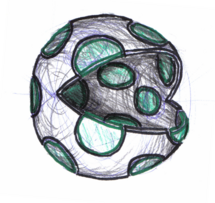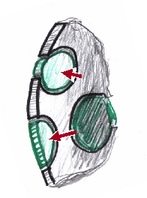Synthesis of Variable Directivity Patterns
On this page, the work of the IEM in synthesis of variable directivity patterns is presented illustratively.IEM Icosahedral Loudspeaker Array and Similar Systems
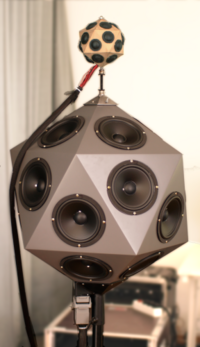 |
Accordingly, the only sensible way of getting decent results is the usage of multiple array systems operating in different frequency bands. In the photo, the IEM icosahedral loudspeaker array is depicted. There are several other interesting array systems within academic contexts, as for example:
Some of my overview slides: sphLS0, sphLS1, sphLS2. |
Spherical Cap Model of Spherical Loudspeaker Arrays
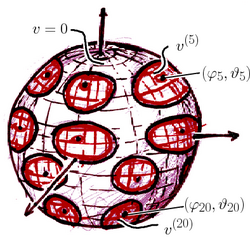 |
In order to reproduce radiation patterns of musical instruments, it is at first very interesting to figure out, what the capabilities of specific loudspeaker arrangements are. In our work, spherical arrangements are considered suitable, as directivity patterns are also best described in the spherical coordinate system. This choice also provides a good basis for analytic description for the design of the arrangement. Consider a solid sphere, into which spherical caps are mounted that can vibrate individually into the radial direction at given velocity. The radiated soundfield is best described with the spherical harmonics and the spherical Hankel functions. The attempt of producing spherical harmonics with the given model leads to linear combinations of spherical harmonics only; we refer to this aspect as spatial aliasing, or better angular aliasing. |
Condition for Suppression of Angular Aliasing
| In order to suppress spatial aliasing, an upper cutoff frequency must not be exceeded and a certain minimum distance from the origin of the array has to be kept. The ranges for some platonically sampled loudspeaker arrays are provided in the diagrams. k is the wave number, r0 the array radius, and r the distance of the synthesis target to the center of the array. Approximately, the diameter 2r0 of the array must be smaller than the wavelength, and the diameter 2r of the synthesis sphere must be larger than 2 wavelengths, in order to suppress aliasing. | 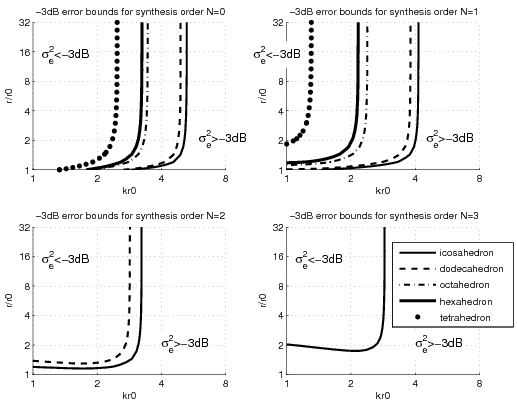 |
Full Mechanical, Acoustical, and Electrical Model of Bass Array Interaction
|
Taking into account the mechanical and electrical impedance of the loudspeaker systems, a first model with independently controlled loudspeakers can be built. To complete a full model of spherical bass-range loudspeaker arrays, the interaction of the speakers over the interior and exterior sound field has to be considered. A suitable acoustical model for that purpose is a spherical shell with vibrating caps, like the one depicted on the left. Finally, using appropriate mathematical descriptions, we obtain a multiple voltage-in and multiple mechanic velocity-out system. We are working on a comparison of the results to laser Doppler vibrometry and microphone array measurements to prove their usefulness. |
Basic Spherical Beamforming Setups
There are several ways to solve the angular beamforming problem. Basically there are two possible setups in which the problem could be solved:- The sound particle velocity distribution on the array surface is identified (i.e. laser vibrometry measurement, or analytically modeled) and can be controled
- The sound pressure distribution on a sphere bigger than the array is identified (with a microphone array) and can be controled
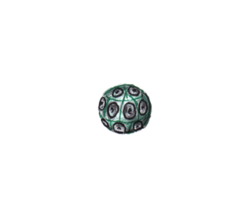
|
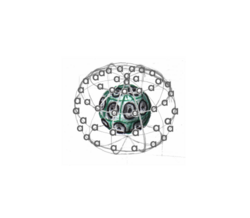
|
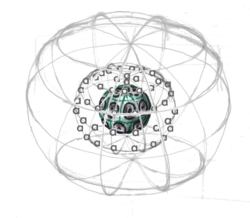
|
With filters for radial spherical beamforming, the controlable spherical harmonics pattern can also be re-synthesized at another target sphere than the primarily controlable one. Some illustrations thereof are depicted above: a) the primary synthesis surface of the sound particle velocity, b) the primary sound pressure synthesis surface using a spherical microphone array, and c) both cases can be "re-focused" to a target sphere at an other radius that is at least r>r0.
Further information on this subject is provided on:
- IEM-Report 39/07:
"Icosahedral Loudspeaker Array", here, 2007. - Franz Zotter, Alois Sontacchi, Robert Höldrich:
"Modeling Spherical a Loudspeaker Systems as Multipole Source", DAGA, Stuttgart, here, March 2007. - Franz Zotter, Robert Höldrich:
"Modeling Radiation Synthesis with Spherical Loudspeaker Arrays", ICA, Madrid, here, September 2007. - Franz Zotter, Markus Noisternig:
"Near- and Far-Field Beamforming Using Spherical Loudspeaker Arrays", 3rd AAAA Congress, Graz, here, September 2007. - Franz Zotter, Andy Schmeder, Markus Noisternig:
"Crosstalk Cancellation for Spherical Loudspeaker Arrays", DAGA, Dresden, here, March 2008. - Diploma Thesis: Hannes Pomberger.
"Angular and Radial Directivity Control for Spherical Loudspeaker Arrays", here, 2008. - Franz Zotter, Hannes Pomberger, Andy Schmeder:
"Efficient Directivity Pattern Control for Spherical Loudspeaker Arrays", here, ACOUSTICS08, Paris, July, 2008.
Franz Zotter, 2007.


